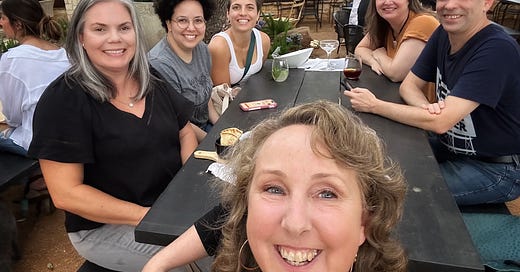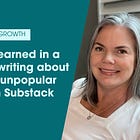Setting our own success metrics
We've bought into the idea of overnight success so much that we've forgotten what real progress looks like.
It’s so easy to fall into the comparison trap, especially if you’re a writer, creator, solopreneur, brand builder, author, founder, side hustler, mother, mountain biker, worker bee, or just someone trying to make a name for yourself in this uber-competitive race we call life.
We are conditioned to compare ourselves, and we all love a success story. Every crevice of the Internet is filled with so-called experts selling one dream: Success is easy … if you just follow me.
This week, I co-hosted my second
writer’s meetup with at Opa, a charming Greek cafe and coffeehouse on Austin’s South side. Beneath a giant oak, our group of six gathered at a large picnic table to talk shop. One of the big topics floating about was what success on the platform looks like. Ironically, another topic that came up was the "arrival fallacy," spurred by ’s latest post, the belief that achieving a significant goal will bring happiness, which often, it does not.We’ve been so dazzled by those "overnight" successes, we’ve lost sight of what real progress looks like.
Jen shared the story of a friend she recently helped start a Substack newsletter. Without an existing email list, this person had converted thousands of her Instagram followers into subscribers. We all leaned in to listen—what was her secret?
The secret is that this woman wasn’t starting from scratch. She’s
, a James Beard-awarded pastry chef, co-owner of the famed Tartine Bakery, and author of numerous books, and she has been building her business for over 20 years.We have to remember that we didn’t all start together, and progress looks different for each of us.
One of the writers in attendance mentioned seeing steady progress by writing consistently and using Notes, Substack’s internal social platform. She had gotten a subscriber bump after being mentioned in a piece by someone with a larger following. The numbers weren't “huge,” but they were respectable. Yet, she questioned, was this adequate progress?
We’ve been so conditioned to believe that overnight success is the norm, that when we see consistent, steady growth, we think we must be doing something wrong.
In the early days, consistent, steady growth is a sign that we’re doing it right and should keep doing it. There’s often a tipping point in content marketing when efforts start to compound. That snowball gets bigger and rolls faster down the hill the further it goes, but we often don’t recognize it until two, three, sometimes four years of laying the foundation and doing slow, steady work.
Initially, it’s about identifying small signals of what’s working, establishing sustainable, repeatable practices, and then building on them. Most of us don’t want to hear this.
I can’t tell you how to stop comparing yourself—I still fall into that trap occasionally. The best advice I can offer is to recognize it’s going to happen and take care of yourself in the moment. You might need to detach from certain metrics, like unsubscibes, and unfollow those whose success makes you doubt your own.
But more and more, I’m finding more joy by leaning into where I am in the journey.
After I earned the Top Voice badge on LinkedIn a couple of weeks ago, I got comments from people like, “Wow! It’s crazy you were able to get the badge with less than a thousand followers.” For people with huge followings and highly engaged audiences, snagging the badge isn’t hard if you know what you’re doing. But if you have a smaller audience, it’s challenging.
A less confident version of myself might have shrunk at those statements or downplayed the win. I decided to do the opposite.
One of the things landing the badge made me realize is I can do more to help those who aren’t as far along as I am and even those who appear successful but aren’t seeing comparable results. My focus is on making an impact within my sphere of influence while continuing to build and grow.
By the way, the week after I received the Top Voice badge marked my best performance ever on LinkedIn. While I can’t confirm that the badge directly boosted my reach, I believe it’s made more people take notice when connecting, even those with larger followings.
So take that, comparison.
Now it’s your turn. I’d love to hear your strategies for dealing with the comparison gremlins.
Also, I created a guide to how I landed the Top Voice badge on LinkedIn, which I’m giving away for the next two weeks to new subscribers (yes, even free subscribers). If you’re already subscribed and want a copy, hit reply to this email, send me a DM or let me know in comments below.
Related reading:








For me, it's learning this kind of stuff is all normal, and human, it's just we don't always talk about it. Comparison is a natural thing for social animals to do, and it's basically unavoidable, so the key is to get smarter and more mindful about it, and whenever possible, wrapping it in a soft blanket of self-compassion.
Thanks for this reminder, Kristi! So great seeing you the other day :)